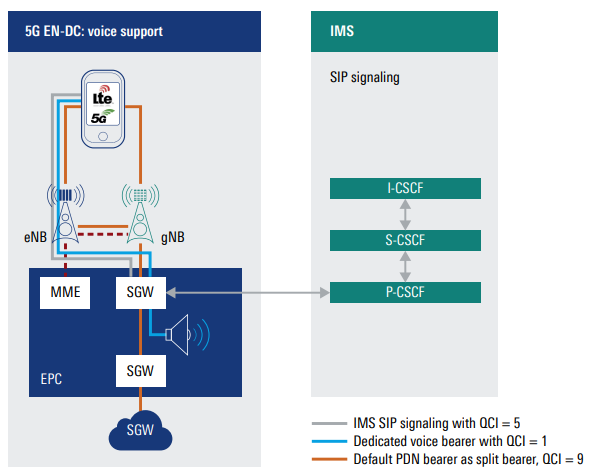Recent deployments of 5G widespread use of option 3X as one option in the connectivity scenario background in the infrastructure evolution. As a result, EN-DC, where there are two radio links, E-UTRA, and 5G are offered. To accelerate the introduction of voice services, the major aspect of this method is that NR does not support voice services at all since this will be covered by LTE.
The principle in EN-DC mode is that 5G NR cannot exist standalone; thus, LTE coverage is the prerequisite. Operators who have deployed VoLTE for 4G can continue to use IP Multimedia Subsystem (IMS) services over E-UTRAN (partially or fully upgraded to EN-DC).
There is no impact on IMS. In fact, the IMS system is not even aware of the E-UTRAN upgrade to EN-DC. All location information exposed to IMS is based on LTE, as before.
Voice Options in 5G Technology
In non-standalone deployment, VoLTE is used as a default voice solution, however, in standalone deployment, the equivalent of VoLTE is VoNR which is one of the possible voice solutions in 5G.
Another solution is EPSFB (Evolved Packet Switched Fallback) which would require a 4G layer under the SA system and may be considered as an intermediate solution keeping in mind the end goal of VoNR. At a high level, EPSFB is equivalent to CSFB (Circuit Switched Fallback) as we saw in the past when 4G was introduced on the top of 3G.
The third solution is RAT Fallback (Radio Access Technology Fallback) which is mainly applicable to 3GPP defined deployment options 5 and 7, which are options not utilized in nowadays networks.
5G Voice services using EPS fallback
The prerequisite for voice services is support for IMS, which is the case in EN-DC since the EPC is connected to IMS already. A possible recommendation includes the setup of an IMS packet data network (PDN) connection for session initiation protocol (SIP) signaling messages inheriting the LTE QoS profile QCI = 5 and a parallel PDN connection for the voice content inheriting QCI = 1, as is already recommended for VoLTE.

Since the setup supports dual connectivity, a third PDN default bearer with suggested QCI = 9 can now operate as a split bearer to provide additional packet data over E-UTRA and NR radio interfaces. It would be up to the network implementation and UE maturity whether the NR link is suspended or maintained simultaneously to the E-UTRA bearer.
This proposal represents an early implementation with support for voice services when deploying 5G since it reuses investments that operators made into their LTE network. Bit rate and latency requirements are easily satisfied over LTE. From a longer-term rollout perspective, EN-DC option 3 may represent an interim stage that extends the existing EPS by a concurrent 5GC deployment and then allows support for VoNR.
References:
- Rohde & Schwarz, 5G VOICE OVER NEW RADIO (VoNR) White Paper
- Nokia, Voice over 5G (Vo5G) core
- MediaTek, 5G NR Voice Solutions Overview and Deployment Guidelines White Paper
